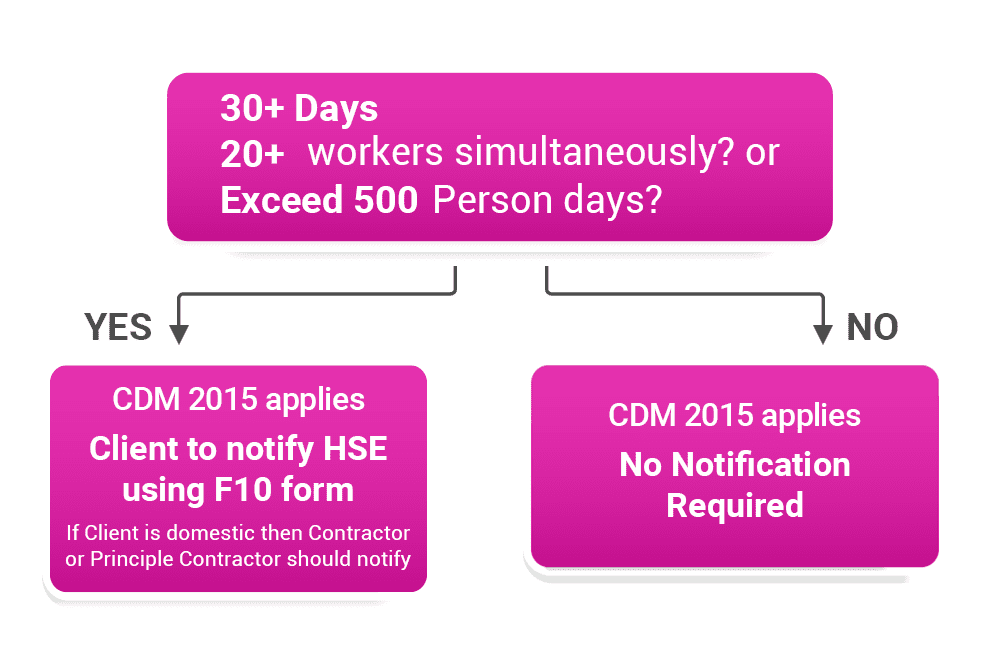
Any type of construction project that is to be undertaken in the UK must adhere to the Construction (Design and Management) Regulations (CDM 2015). Under these regulations there are specific documentation requirements. A failure to notify the relevant authorities when required can result in significant fines.
It should be noted that these documentation requirements will still apply under CDM 2020. What are CDM Regulations 2020? CDM 2020 is a regulatory update to CDM 2015. But this change has been pushed back to a later date. Currently, the CDM Regulations 2015 still apply; although at some point, the new CDM regulations 2020 will be brought into force.
In this blog, we will outline what documentation, under CDM Regulations 2020 and CDM Regulations 2015, is required in the pre-construction phase of a project.
Notifiable Projects
All projects, whether they are domestic or commercial, have to be notified to the Health and Safety Executive (HSE) when they reach a certain size.
This is because the HSE keep a closer eye on larger projects during both the Pre-Construction and Construction Phases. They are likely to conduct site visits and check for CDM requirements on larger sites.
However, it is very important to note that, just because a project is not large enough to be notifiable to the HSE, it does not mean that there are no CDM requirements. The qualifying criteria apply regardless of the size of the project, so even quite small jobs can easily be covered by the CDM Regulations.
What is the Notification Criteria
Under the CDM Regulations, the HSE must be notified if:
- Work is scheduled to last longer than 30 working days and has more than 20 workers working simultaneously at any point in the project, or
- The project exceeds 500 person days
A project may be notifiable irrespective of the number of contractors involved.
Who is Responsible for HSE Notification
The Client is responsible for notifying the HSE, on normal commercial or non-domestic projects.
On domestic projects, this responsibility is taken over by the Contractor or Principal Contractor who notifies HSE on behalf of the Client.
When Should Notification Occur?
The HSE must be notified at the earliest point once it becomes clear that the notification criteria are likely to be triggered. Normally, this will be in the Pre-Construction Phase before construction work begins.
However, it is possible that during the early planning stages, the project may appear to be too small to trigger the notification process, but, as it progresses, it exceeds the limits.
In this scenario, if a construction project does not appear to be notifiable, but subsequent changes to its scope mean that it then fits the criteria, then the client must notify the work to the relevant enforcing authority. This should be done as soon as possible, even if the construction work has begun.
How Do You Notify the HSE of a Construction Project?
CDM project notification can be undertaken:
- Online, via the HSE website
- By paper, using form F10 – Notification of Construction Project before the construction phase begins
Establishing if a Project is Notifiable

The above diagram illustrates the key decisions, when establishing if a project is notifiable.
As mentioned, first assess if the work will go 30+ working days and have more than 20 workers working simultaneously at any point in the project, if it will exceed 500 person days?’
If your answer is yes, then:
- CDM 2015 applies in full
- The client must notify the HSE using form F10
If the client is domestic, then the contractor or principal contractor should notify HSE.
If your answer is no, then:
- CDM 2015 applies in full whether the project is domestic or commercial
- No notification is required
What Information Does HSE Have To Be Notified About?
Schedule 1 of the CDM Regulations provides full details of the information that has to be submitted to the enforcing authorities. This includes:
- Information about where and when the construction project will be carried out
- A description of the project, and
- The construction work it entails
Project Documentation Requirements
The fourth element is the project documentation requirements. The CDM regulations require that three main documents are assembled and used to control construction projects:
- Pre-construction information – This includes all the information developed during the design stage of a project
- A construction phase plan – Which details and controls how the project will be carried out
- A health and safety file – Which acts like an operations manual after the construction work has finished
We will cover the construction phase plan and the health and safety file in later blogs, but let’s now consider the pre-construction information.
Understanding Pre-construction Information?
During the pre-construction phase, the design team must start to pull together the necessary information to support the safe completion of the project. The pre-construction information supports the preparation of the construction phase plan.
In particular, the pre-construction information helps Designers and Contractors, whether they are bidding on the project or already appointed, to carry out their duties. It also assists Principal Designers and Principal Contractors with planning, managing, monitoring, and coordinating the work of the project.
What to Include in the Pre-construction Information
The pre-construction information must include documents such as:
- Site surveys
- Architectural drawings and specifications, and
- Planning applications
It is basically all the information that provides a basis for the preparation of a construction project.
Under CDM regulations 2015, the pre-construction information must include information about the project details, such as the client brief, key dates of the construction phase, and the planning and management of the project, such as the resources and time being allocated to each stage of the project.
It must include arrangements to ensure cooperation between duty holders, and that the work is coordinated. There should be details regarding health and safety hazards on site, including information on any design and construction hazards and how they will be addressed.
The information must be relevant to the particular project. Generic details are not acceptable. The documentation must have an appropriate level of detail. A large project will require far more information than a short job. The documentation and information supplied must be proportionate to the risks involved. Where there are significant risks, there must be suitable detail to address how they will be managed.
How to find out more about CDM Regulations 2020
At present, there is no link to the CDM regulations 2020 pdf on the HSE website. However, the CDM 2015 pdf is still available. It is expected that the proposed changes will not alter the CDM 2015 regulations in a major sense. So, the existing CDM 2015 Regulations is still a good starting point if you want an answer to the question – what are the CDM regulations 2020? Or you require a CDM regulations 2020 summary.
To further your knowledge of how the CDM regulations work in practice, you can take a Human Focus online training course. The Human Focus Construction Design Management (CDM) Awareness course provides participants with a good grounding in the CDM regulations.
CDM Duty Holder Training is ideal for those who wish to improve their understanding of the respective roles and duties of all people involved in a construction project. Both courses are assured by the Royal Society for the Prevention of Accidents (RoSPA) and come with a certificate upon successful completion.
































































































































































































































































































































































































































































































































































































































































































































































